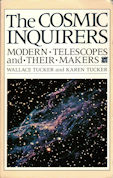Since its launch on July 23, 1999, aboard the space shuttle Columbia,
NASA’s Chandra X-Ray Observatory—the most powerful X-ray telescope ever built—has
provided us with spectacular visions of the universe
largely hidden from telescopes sensitive only to visible light.
Now, in Chandra’s Cosmos, Wallace H. Tucker,
science spokesperson for the Smithsonian Astrophysical Observatory’s Chandra X-Ray Center,
narrates the orbiting space telescope’s exploration of
the high-energy face of the universe and its latest revelations
about dark matter and dark energy, supermassive black holes, neutron stars and pulsars,
titanic galaxy clusters, the cosmic web, and the life and death of stars.
Dozens of dazzling color photographs, layering both data recorded by Chandra
and images from other path-breaking telescopes, present extraordinary new views of our cosmos.
From Chandra’s imaging of the glowing remains of supernovas
through its observation of the black hole at the center of our own Milky Way galaxy
to its tracing of the separation of dark matter from normal matter
as huge galaxies collide at unimaginable speeds,
the book explores the full implications of the telescope’s discoveries,
while its revelatory illustrations bring them to brilliant life.
This is space as you have never seen it before.


